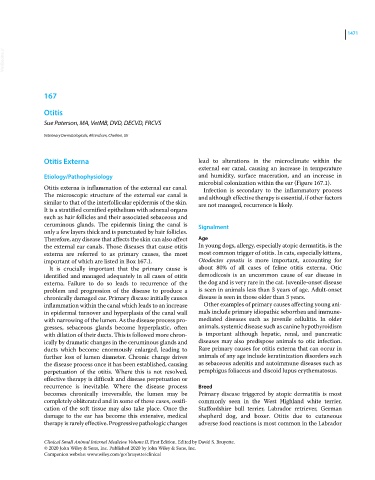Page 1533 - Clinical Small Animal Internal Medicine
P. 1533
1471
VetBooks.ir
167
Otitis
Sue Paterson, MA, VetMB, DVD, DECVD, FRCVS
Veterinary Dermatologicals, Altrincham, Cheshire, UK
Otitis Externa lead to alterations in the microclimate within the
external ear canal, causing an increase in temperature
Etiology/Pathophysiology and humidity, surface maceration, and an increase in
microbial colonization within the ear (Figure 167.1).
Otitis externa is inflammation of the external ear canal. Infection is secondary to the inflammatory process
The microscopic structure of the external ear canal is and although effective therapy is essential, if other factors
similar to that of the interfollicular epidermis of the skin. are not managed, recurrence is likely.
It is a stratified cornified epithelium with adnexal organs
such as hair follicles and their associated sebaceous and
ceruminous glands. The epidermis lining the canal is Signalment
only a few layers thick and is punctuated by hair follicles.
Therefore, any disease that affects the skin can also affect Age
the external ear canals. Those diseases that cause otitis In young dogs, allergy, especially atopic dermatitis, is the
externa are referred to as primary causes, the most most common trigger of otitis. In cats, especially kittens,
important of which are listed in Box 167.1. Otodectes cynotis is more important, accounting for
It is crucially important that the primary cause is about 80% of all cases of feline otitis externa. Otic
identified and managed adequately in all cases of otitis demodicosis is an uncommon cause of ear disease in
externa. Failure to do so leads to recurrence of the the dog and is very rare in the cat. Juvenile‐onset disease
problem and progression of the disease to produce a is seen in animals less than 3 years of age. Adult‐onset
chronically damaged ear. Primary disease initially causes disease is seen in those older than 3 years.
inflammation within the canal which leads to an increase Other examples of primary causes affecting young ani-
in epidermal turnover and hyperplasia of the canal wall mals include primary idiopathic seborrhea and immune‐
with narrowing of the lumen. As the disease process pro- mediated diseases such as juvenile cellulitis. In older
gresses, sebaceous glands become hyperplastic, often animals, systemic disease such as canine hypothyroidism
with dilation of their ducts. This is followed more chron- is important although hepatic, renal, and pancreatic
ically by dramatic changes in the ceruminous glands and diseases may also predispose animals to otic infection.
ducts which become enormously enlarged, leading to Rare primary causes for otitis externa that can occur in
further loss of lumen diameter. Chronic change drives animals of any age include keratinization disorders such
the disease process once it has been established, causing as sebaceous adenitis and autoimmune diseases such as
perpetuation of the otitis. Where this is not resolved, pemphigus foliaceus and discoid lupus erythematosus.
effective therapy is difficult and disease perpetuation or
recurrence is inevitable. Where the disease process Breed
becomes chronically irreversible, the lumen may be Primary disease triggered by atopic dermatitis is most
completely obliterated and in some of these cases, ossifi- commonly seen in the West Highland white terrier,
cation of the soft tissue may also take place. Once the Staffordshire bull terrier, Labrador retriever, German
damage to the ear has become this extensive, medical shepherd dog, and boxer. Otitis due to cutaneous
therapy is rarely effective. Progressive pathologic changes adverse food reactions is most common in the Labrador
Clinical Small Animal Internal Medicine Volume II, First Edition. Edited by David S. Bruyette.
© 2020 John Wiley & Sons, Inc. Published 2020 by John Wiley & Sons, Inc.
Companion website: www.wiley.com/go/bruyette/clinical

